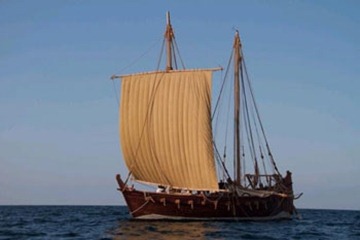The exhibition titled ‘From China to Arabia — Ancient Treasure Ships and the Great Oman Voyage’ organised by the National Geographic at Qurum City Centre has been receiving good response from Omanis and expatriates alike.
 The exhibition, inaugurated on December 14, is the cynosure of people who are making a beeline to witness the event which highlights the great maritime significance between Sultanate and China.
The exhibition, inaugurated on December 14, is the cynosure of people who are making a beeline to witness the event which highlights the great maritime significance between Sultanate and China.
According to tour guide Mubarak Said al Ghailani more than 20,000 people have visited the exhibition venue till December 28. He said families, kids, elders and expats are showing keen interest in knowing more about treasure ships.
The event comes as an initiative by the National Geographic and assumes inspiration from the Jewel of Muscat’s epic voyage from Muscat to Singapore earlier this year.
The Jewel of Muscat’s voyage had enriched Oman’s maritime heritage and culture. The website of the project had attracted more than 80,000 visitors from different parts of the world, especially from the Indian Ocean rim.
The exhibition includes artefacts from Sohar, Qalhat, Bait al Zubair museum in Muscat, and East Asia Museum in Bath City in the United Kingdom.
Expressing her thoughts on the exhibition, Sharifa al Hajri, a ministry employee, said: “We were thrilled to see the details of the treasure ships in this exhibition. Though we have heard stories earlier, it was a great feeling to see it first-hand. It was very informative for my school going kids who are interested in maritime history of Oman.”
Sneha Chandran, an Indian housewife, stated: “We came to shop at Qurum City Centre and by chance we got to know about the exhibition. Since we knew about Jewel of Muscat, the event made more sense in knowing more about China and Arabia connections.”
The exhibition spans the region’s history from 13th to the 16th centuries and demonstrates the deep rooted cultural and commercial relations all the way through between China and the Arabian region.
The exhibition includes six halls and a theatre that was specifically built for this purpose. It recounts the stories of Sindbad and the Chinese admiral Zheng He.
It recounts the story of trade from the 9th to the 16th century and also displays unique goods that highlight the truths about these myths. Nasser al Balushi, a private sector worker, said: “It was worth visiting this exhibition along with my family who were keen to know more about the Arab adventurer Sindbad. I thank the ministries and National Geographic for putting up this show.”
Alex Thompson, who works in Sur, said: “This exhibition is a must see for kids studying in various schools in and around Muscat. It is so informative and quite exhaustive at the same time.”
In the first gallery, an introductory film about the ancient shipwreck discoveries and their connections with the maritime silk route between China and Arabia is shown.
The second gallery is about myths and legends about thriving trade network that connected the mighty Persian and Arabian empires with powerful Tang China.
The made in China gallery highlights the sea-lanes through the Indian Ocean and the South China Sea which saw thousands of Arab, Indian and Persian ships laden with the earliest cargos of Chinese goods travelling to foreign shores.
The fourth gallery is about royal treasures which according to recent archeological studies suggest that sumptuous treasures were carried on board many of the merchant ships.
These treasures often included exceptional gold, silver and bronze items intended as gifts from the Chinese court to Arabian dignitaries.
Some scholars believe that highly prized imperial white and green ceramics were royal dowries for weddings between Chinese princesses and their Arabian princes.
The fifth gallery is about China’s great armada while the sixth is about the rise of European dominance. The seventh gallery tells about the Jewel of Muscat’s voyage which was recreated in February 2010.
The ship, the reconstruction of a 9th century Arab trading ship, set sail from Muscat along the old maritime Silk Route to Singapore recreating the great sea journeys of the past.
A gift of friendship from the Sultanate of Oman to the people of Singapore, the ship stopped in India, Sri Lanka and Malaysia en route before finally arriving in Singapore in July 2010.
The exhibition is being presented by the Ministry of Foreign Affairs and supported by the Ministry of Heritage and Culture.
Authors: Kaushalendra Singh & Bader Zahir al Kiyumi | Source: Global Arab Network [January 01, 2011]